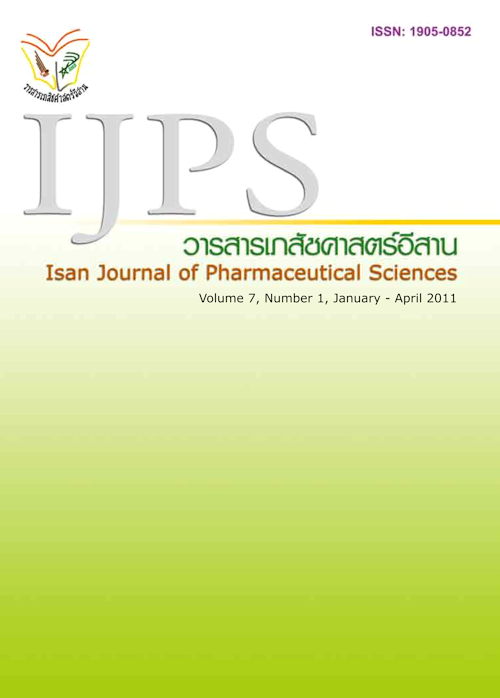A Study of “Harmful Cosmetics” Usage Behavior Among Female Teenagers in Ubon Ratchathani Province
Main Article Content
Abstract
Introduction: “Harmful cosmetics” can cause a lot of adverse effects and problems. Even though they affect the consumer’s physical and mental health, “harmful cosmetic” usage behavior still exist. The objective of this study to fnd the appropriate way to prevent such behavior. Method: Both quantitative and qualitative studies were used in the area of Muang and Warinchamrab District, Ubon Ratchathani Province, with 539 participants. Data were collected by using questionnaires and interviews, and data was analyzed by content analysis and descriptive statistics. Results: Facial cosmetic have the greatest attention paid to them by most from female teenagers. The most important purchase decision factors were a certifcate from the Thai FDA, a creditable brand name and consumer satisfaction. The consumers focused on nourishing face, sun protection and whitening qualifcation, respectively. Knowledge about facial cosmetics was at a low level. The consumer’s inappropriate purchasing were buying at discount market fairs for well known cosmetics, sharing cosmetic with others, and not testing for allergic before use. Allergies, rash and itching were found to be the most common adverse effects. Some of them used the “harmful cosmetic” for requirements of beauty. Conclusion: The appropriate way to prevent “harmful cosmetic” behavior is for the government to enforce the law strictly, provide cosmetic education for entrepreneurs and consumers, safe product of cosmetic test kit support, good inspirations for the consumer protection offcials, a strong surveillance network and instilling the correct values.
Article Details
In the case that some parts are used by others The author must Confirm that obtaining permission to use some of the original authors. And must attach evidence That the permission has been included
References
Bruanasak j. The whitening cream influences self and identity of female workers [thesis master of arts]. Bangkok: Mahidol University; 2006.
Chareonphol P. Study to assess the dangers of cosmetic sun protection. Bangkok: Food And Drug Administration, Ministry of Public Health; 1995.
Department of Mental Health. Mental health promotion for high school student guideline for teacher. Bangkok: ETO publisher; 2001.
Eric P.H.Li, Hyun Jeong Min, Russell W, et al. Skin lightening and beauty in four asian cultures. Adv Consum Res 2008; 35: 444-449.
Ifeinwa F, and Ochei UM. An epidemiological survey on the presence of toxic chemicals in soaps and cosmetics used by adolescent female students from a Nigerian University. JIWS 2004; 5: 85-92.
Joseph F Merola, Shane Meehan, Ruth F Walters, et al. Exogenous ochronosis. DOJ 2008; 14(10): 6.
Kaeworn P. The study of factor and behavior on decision making for purchasing skin care cosmetics for men in Bangkok area. Bangkok: Technology North Bangkok University: 2007.
Katchamas S. Whitening cosmetics products. FDA Journal 2007; 14(2): 22-26.
Khattinanon P. Pronphan Soomthorntham and Supasiri Srichat. Adverse reaction from cosmetics. Bangkok: Food And Drug Administration, Ministry of Public Health: 2002.
Kittipat P. The study of the alteration on consumption begavor in cosmetics for acne and blemish producs in Phrea province. Phrae: Group of Consumer Protection and Health Pharmacy, Hprae Public Health Office: 2009.
Kunapibal N, Thanee S. and Prapatsron W. Cosmetics haqard monitoring. Bangkok: Food And Drug Administration, Ministry of Public Health: 1996.
eah P. Cosmetic contamination awareness among adolescent females [online]. 2007 [cited 2008 Dec 25]. Available from: http://www.amstat.org/education/posterprojects/projects/2008/8-Grades10-12-HM.pdf.
Lertwoot L. The study of decision making behavior on purchasing acne and blemish cosmetics for whitener face in high school and vocational certificate female student in Muang district, Chachoengsao province. FDA Jourmal 2010; 17(2): 33-41.
Marilyn A. Asians turning to cosmetics for lighter skin [online]. 2008 [cited 2009 Dec 25]. Available from: http://www.odt.co.nz/lifestyle/ fashion/5879/asians-turning-cosmetics- promise-lighter-skin.
Nanosearch.co.th. Cosmetics using behavior [Online]. 2008 [cited 2009 Jan 8]. Available from: http://www.siamturakij.com/home/news/display_news.php?.
Nuchanat S. Psychology of Adolescen. Thon Buri: Rajabhat Institute Thon Buri; 1999.
Phanak S. The study of factor and knowledge on decision making to purchasing cosmetics for face in female, Sam Leam community. Khon Kaen: Faculty of Medicine, Khon Kaen University; 2006.
Phattaradumneonrut W. Control and supervising problems of facial sun block and whitening cosmetics. Bangkok: Food And Drug Administration, Ministry of Public Health; 2001.
Phupoksakul N. Thailand: Cosmetic products market. U.S. and Foreing Commercial Service and U.S. Department of State [online]. 2007 [cited 2009 Dec 25]. Available from: http://www.buyusa.gov
Praveenawongwoot V, Jaiwat N. Consumer cosmetics behavior. Bangkok: Food And Drug Administration, Ministry of Public Health: 1997.
Punyapathiyarn A. How to use cosmetics safely. FDA Journal 2004; 11(3) L 11-16.
Puyakul S. The study of factors associated with cosmetics consumption behavior of undergraduae student in public university [thesis master of art]. Bangkok: Kasetsart University; 1997.
Raul Charlin, Carlos B. Barcaul, Bermard Kawa Kac, et al Hydroquinone-induced exogenous ochroniosis: a report of four cases and usefulness of dermoscoyp. IJD 2008; 15(1): 85-91.
Sakulphuk J. The study of knowledge level and behavior of health product consumption of Phuket people. FDA Journal 2008; 15(1): 85-91.
Viriyakitpattana K. and Asawasittitawon V. Customer Behavior. Bangkok: Wand Aksorn; 2007.
Westerhof W. and Kooyers TJ. Hydroquinone and itsbanaloques in dermatoltgy-a potential health risk. JCD 2005; 4: 55-59.


